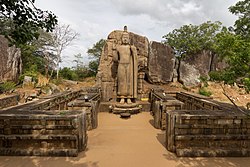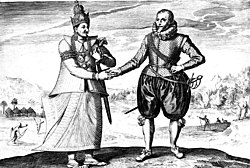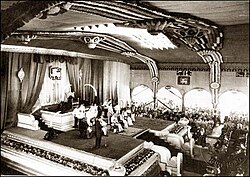Sri Lanka
The Democratic Socialist Republic of Sri Lanka (ශ්රී ලංකා in Sinhala, இலங்கை in Tamil) is a tropical island nation located in the Indian Ocean just off the Southern coast of India. The capital of the country is Sri Jayawardenepura Kotte while the largest city is Colombo. Sri Lanka shares a sea boundary with the Maldives in the south-west and India in the north-west.
Democratic Socialist Republic of Sri Lanka | |
|---|---|
| Anthem: | |
 | |
| Capital | Sri Jayawardenepura Kotte (legislative)[1] Colombo (executive and judicial)[2] 6°56′N 79°52′E / 6.933°N 79.867°E |
| Official languages | Sinhala Tamil[3] |
| English | |
| Ethnic groups (2012[4]) | 74.9% Sinhalese 11.2% Sri Lankan Tamils 9.2% Sri Lankan Moors 4.2% Indian Tamils 0.5% Others (incl. Burghers, Malays, Veddas, Chinese, |
| Religion (2012) | 70.2% Buddhism (official)[5] 12.6% Hinduism 9.7% Islam 7.4% Christianity 0.1% Other/None |
| Demonym(s) | Sri Lankan |
| Government | Unitary parliamentary constitutional republic |
| Anura Kumara Dissanayake | |
| Harini Amarasuriya | |
| Mahinda Yapa Abeywardena[6] | |
| Jayantha Jayasuriya | |
| Legislature | Parliament |
| Independence from the United Kingdom | |
• Dominion | 4 February 1948 |
• Republic | 22 May 1972 |
| 7 September 1978 | |
| Area | |
• Total | 65,610 km2 (25,330 sq mi) (120th) |
• Water (%) | 4.4 |
| Population | |
• 2019 estimate | |
• 2012 census | 20,277,597[8] |
• Density | 327/km2 (846.9/sq mi) (43rd) |
| GDP (PPP) | 2020 estimate |
• Total | |
• Per capita | |
| GDP (nominal) | 2020 estimate |
• Total | |
• Per capita | |
| Gini (2016) | 39.8[10] medium |
| HDI (2019) | high · 72nd |
| Currency | Sri Lankan rupee (Rs) (LKR) |
| Time zone | UTC+5:30 (SLST) |
| Date format |
|
| Driving side | left |
| Calling code | +94 |
| ISO 3166 code | LK |
| Internet TLD | |
Website www | |
It was known as Ceylon before 1972, and Serendib and Sinhale, among other names, before that.
Ethnic make-up
Sri Lanka has three main ethnic groups.
The largest of the three groups are the Sinhalese. Most of them are Buddhist. Their language is Sinhala which is an Indo-Aryan language. They make up about 75% of the population.
The second largest group are the Tamils who are Dravidian. They are mostly Hindu and mostly live in the north. They speak the Tamil language which is a Dravidian language. There are about 2,271,000 Tamils in Sri Lanka.
The third largest group are the Sri Lankan Moors. They are Muslim. There are over 1.5 million people in this group. They are predominantly Tamil speakers.
Other than these three main groups, there are burghers (descendants of colonial ancestors), Malays and Chinese.
There is also a small indigenous population called 'veddas'.
The total population of the island is over 22 million people.
History
The island has a recorded history of over 2500 years. Buddhist missionaries were sent from India in 250 BC during the reign of Emperor Ashoka of the Mauryan Empire. The kings of the island, and eventually most of the Sinhalese people, became Buddhists. Legend has it that Buddha visited the island three times.
There were many Sinhalese Kingdoms such as Anuradhapura, Polonnaruwa, Dambadeniya, Kotte and Kandy. The Island also faced several invasions from India and one such invasion led to the establishment of the Jaffna Kingdom in the North.
The island was subject to colonisation beginning with the Portuguese in the 16th and 17th centuries, the Dutch in the 17th and 18th centuries, and lastly the British from 1796 to 1948. The British traded as the others had done, but also developed plantations of coffee and tea. Tea was planted after a fungus destroyed the coffee plantations in 1869. The tea plantations were the basis of Sri Lankan prosperity for a hundred years. Lastly, rubber plantations were started in the early 20th century. In 1965, Ceylon became the world's leading exporter of tea, with 200,000 tonnes of tea being shipped internationally annually.[12]
Independence from Britain was gained in 1948, together with Dominion status in the British Commonwealth of Nations. In 1972, Ceylon changed its name officially to the Republic of Sri Lanka, and is still a member of the Commonwealth.[13]
The Sri Lankan Civil War against Tamil separatists(LTTE) erupted in 1983 and only came to an end in 2009. In the 2010s, tourism rapidly grew as a source of foreign investment and currency. An economic crisis in the early 2020s led to civil unrest.
National symbols of Sri Lanka
Flag
The Sri Lanka flag also known as the Lion flag has a Lion holding a sword in its right paw. The lion represents bravery. There is a Bodhi leaf in each corner which represent the four Brahmaviharas of Buddhism. The colours Crimson, Orange and Green represent the Sinhalese, Tamils and Moors respectively.
Provinces
Sri Lanka has 9 provinces.
Sri Lanka Media
Ptolemy's world map of Ceylon, first century CE, in a 1535 publication
The Avukana Buddha statue, a 12-metre-tall (39 ft) standing Buddha statue from the reign of Dhatusena of Anuradhapura, 5th century
The Sigiriya ("Lion Rock"), a rock fortress and city, built by King Kashyapa (477–495 CE) as a new more defensible capital. It was also used as a Buddhist monastery after the capital was moved back to Anuradhapura.
The seated image of Gal Vihara in Polonnaruwa, 12th century, which depicts the dhyana mudra, shows signs of Mahayana influence.
A 17th-century engraving of Dutch explorer Joris van Spilbergen meeting with King Vimaladharmasuriya in 1602
A 1595 map of Sri Lanka created by Dutch cartographer Petrus Plancius
Sri Vikrama Rajasinha of Kandy, the last ruling native Sri Lankan monarch
The formal ceremony marking the start of self-rule, with the opening of the first parliament at Independence Square
Related pages
Notes
References
- ↑ "Sri Jayewardenepura Kotte". Encyclopædia Britannica. Retrieved 12 May 2020.
- ↑ "Colombo". Encyclopædia Britannica. Retrieved 12 May 2020.
- ↑ "Department of Official Languages". Archived from the original on 2016-09-06. Retrieved 2021-01-13.
- ↑ "South Asia: Sri Lanka". CIA. 8 March 2022.
- ↑ "Ashik v Bandula And Others (Noise Pollution Case)" (PDF). www.lawnet.gov.lk. Archived from the original (PDF) on 1 March 2020. Retrieved 6 January 2021.
- ↑ "Hon. Mahinda Yapa Abeywardena elected as the New Speaker". Parliament of Sri Lanka. 20 August 2020. Retrieved 23 August 2020.
- ↑ "Mid-year population projection" (PDF). Archived from the original (PDF) on 17 November 2017. Retrieved 30 October 2018.
- ↑ "Census of Population and Housing 2011 Enumeration Stage February–March 2012" (PDF). Department of Census and Statistics – Sri Lanka. Archived from the original (PDF) on 6 December 2013. Retrieved 15 July 2014.
- ↑ 9.0 9.1 9.2 9.3 "World Economic Outlook Database, October 2019". IMF.org. International Monetary Fund. Retrieved 8 December 2019.
- ↑ "Gini Index". World Bank.
- ↑ Human Development Report 2020 The Next Frontier: Human Development and the Anthropocene (PDF). United Nations Development Programme. 15 December 2020. pp. 343–346. ISBN 978-92-1-126442-5. Retrieved 16 December 2020.
- ↑ "Archived copy" (PDF). Archived from the original (PDF) on 2011-07-10. Retrieved 2015-01-24.
{{cite web}}: CS1 maint: archived copy as title (link) - ↑ Dominion of Ceylon: definition of Dominion of Ceylon in the Free Online Encyclopedia. Encyclopedia2.thefreedictionary.com. [1]
Other websites
Government
Business
Other
- Virtual Library Sri Lanka
- The CIA World Factbook - Sri Lanka Archived 2018-12-24 at the Wayback Machine
- Sri Lanka - UNESCO World Heritage Centre
- Collection of slides of Sri Lanka, University of Pennsylvania library Archived 2018-11-18 at the Wayback Machine
- NIGHANTAYA | The Environment Friendly E Community | Sri Lanka[dead link]













